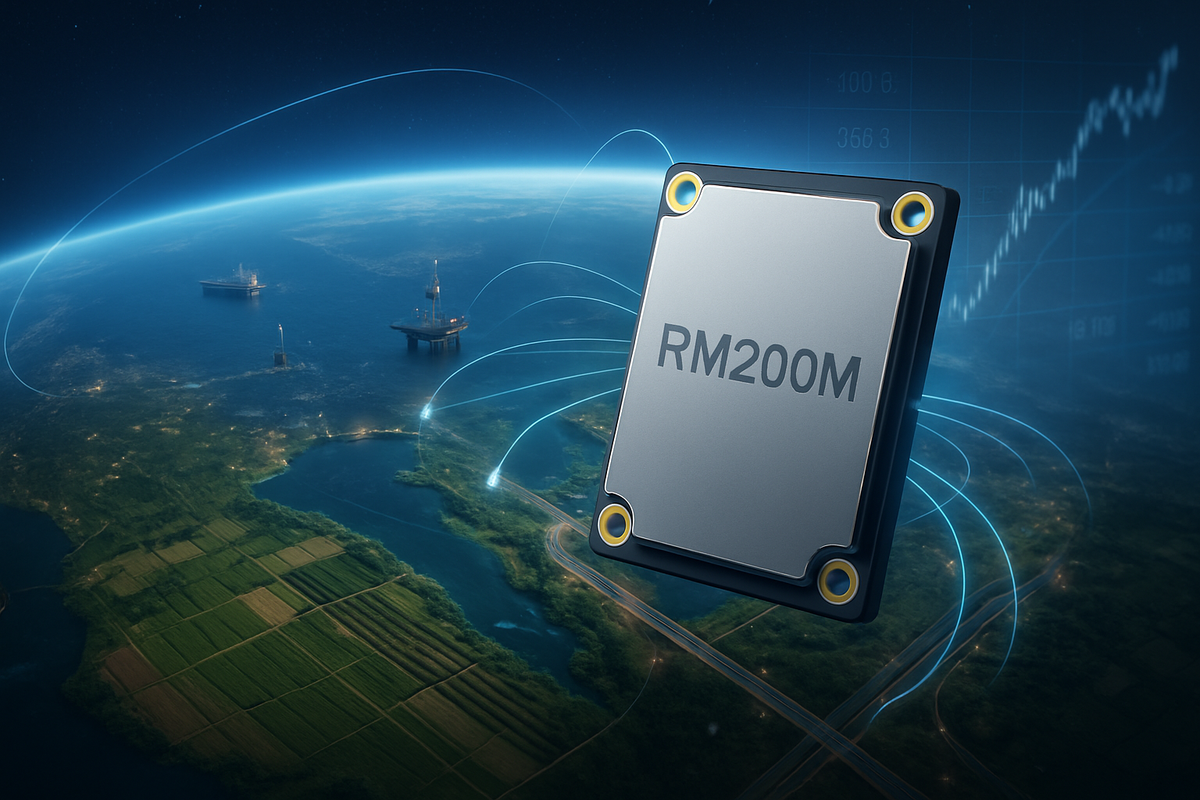
Globalstar Inc. (NASDAQ: GSAT) saw its stock climb by 4.1% today, October 21, 2025, following the commercial launch of its highly anticipated RM200M two-way satellite IoT module. This pivotal development marks a significant step for the satellite communications company, as it officially rolls out a solution designed to expand the reach and capabilities of the Internet of Things across various industries worldwide.
The introduction of the RM200M is poised to unlock new opportunities in remote asset tracking, monitoring, and control, leveraging Globalstar's robust satellite network. The positive market reaction underscores investor confidence in the module's potential to capture a substantial share of the rapidly growing satellite IoT market, offering reliable connectivity in areas where traditional terrestrial networks are unavailable or impractical.
A New Era for Global Connectivity: The RM200M's Commercial Debut
The commercial launch of Globalstar's (NASDAQ: GSAT) RM200M two-way satellite IoT module on October 21, 2025, represents the culmination of a strategic development cycle aimed at revolutionizing global asset management and monitoring. This compact yet powerful module is engineered to provide resilient, affordable, and truly global two-way communication leveraging Globalstar's advanced Low Earth Orbit (LEO) satellite network. Unlike traditional one-way tracking solutions, the RM200M enables real-time interactive communication, offering a significant leap forward in IoT capabilities for industries operating in remote or underserved areas.
At its core, the RM200M boasts a single-stack chip design for seamless connectivity and cost-efficient hardware integration. It is the first satellite module of its kind to feature an integrated GNSS (supporting GPS, GLONASS, BeiDou, Galileo), Bluetooth® Low Energy 5.4, a 3D accelerometer, and an application processor. These integrated peripherals, combined with edge computing capabilities, allow devices to process data locally, reducing latency and making it ideal for mission-critical, off-grid applications. Its "Zero Touch Provisioning" simplifies device configuration, while its integration with Globalstar's Realm Edge Applications Platform and Realm Cloud provides comprehensive device and data management.
The journey to this commercial launch began in February 2025, when Globalstar first introduced its new two-way satellite IoT solution, signaling a strategic pivot from its previous one-way offerings. Following this announcement, the RM200M underwent extensive beta testing with key customers, demonstrating its efficacy and ease of integration. Prominent beta partners included Lasso Technologies, LLC, a leader in oil and gas tank monitoring, and TGI Connect, a transportation technology provider. Both companies lauded the module's ability to accelerate development timelines and expand their service offerings, with Lasso Technologies reporting significant reductions in development time. The positive market reaction, evidenced by Globalstar's stock surge, underscores the industry's anticipation and confidence in the RM200M's potential to address critical connectivity gaps.
This commercial rollout is not just about a new product; it's about establishing a robust ecosystem. Globalstar offers an RM200M Development Kit and access to Globalstar GitHub, fostering a collaborative environment for developers and integrators to build and test their solutions. Key players like Spotter International are also poised to benefit, leveraging the RM200M to maintain connectivity with critical assets, thereby improving operational efficiency and minimizing downtime across various sectors, from logistics and energy to agriculture and environmental monitoring.
Shifting Sands: Winners and Losers in the Evolving IoT Landscape
The commercial debut of Globalstar's (NASDAQ: GSAT) RM200M module is poised to send ripples across the satellite and terrestrial Internet of Things (IoT) markets, creating clear beneficiaries and presenting significant challenges for others. Globalstar itself stands as the most immediate winner, with its stock already reflecting investor optimism. The RM200M represents a strategic pivot and enhancement for the company, moving from predominantly one-way messaging to robust two-way communication, offering an integrated, cost-effective solution that is already being adopted by key customers like Lasso Technologies, LLC and TGI Connect.
Among its competitors, the impact will be varied. Established players like Iridium Communications Inc. (NASDAQ: IRDM), with its strong focus on multi-mode and 3GPP NTN (Non-Terrestrial Network) services, may also benefit from the overall expansion and validation of the satellite IoT market that Globalstar's innovation helps to drive. As the demand for ubiquitous connectivity grows, the market pie enlarges, potentially creating opportunities for multiple robust providers. However, the RM200M's emphasis on affordability, low power consumption, and simplified integration could exert pressure on competitors to innovate and reduce their own costs and complexities to remain competitive in mass-market deployments.
Traditional terrestrial IoT providers face a nuanced scenario. Rather than outright displacement, the RM200M and the broader satellite IoT trend offer an opportunity for expanded coverage and new use cases. Terrestrial networks often have gaps in remote, maritime, or aerial environments. Satellite IoT fills these voids, enabling new applications in sectors like agriculture, logistics, and energy where continuous connectivity is paramount. The RM200M's future-proof design, supporting seamless integration with cellular networks, encourages hybrid connectivity models. This means terrestrial providers can extend their services by partnering with satellite operators, offering more comprehensive and resilient solutions. Those who embrace this hybrid model are poised to win, while those resistant to integrating satellite capabilities might lose market share in remote applications.
Conversely, some players may face headwinds. Satellite IoT providers who have historically relied on primarily one-way offerings will find their solutions less competitive as the market increasingly demands two-way command and control functionalities. Similarly, companies offering high-cost or overly complex satellite IoT solutions will be challenged by Globalstar's more accessible and integrated approach. Smaller, niche Low Earth Orbit (LEO) IoT players, while innovative, might struggle to compete on the scale, global coverage, or integrated features offered by an established player like Globalstar without substantial investment or strategic alliances. The growth of companies like AST SpaceMobile (NASDAQ: ASTS), focused on direct-to-device satellite connectivity, also highlights the broader trend towards non-terrestrial networks, pushing all players to adapt or risk being left behind.
A Catalyst for Connectivity: Broader Implications and Industry Shifts
Globalstar's (NASDAQ: GSAT) commercial launch of the RM200M module on October 21, 2025, transcends a mere product release; it acts as a significant catalyst, accelerating several profound shifts within the satellite and broader Internet of Things (IoT) industries. This move firmly entrenches the trend towards two-way communication in satellite IoT, moving beyond basic tracking to enable real-time command and control of remote assets. This capability is crucial for advanced applications in logistics, energy, agriculture, and environmental monitoring, where immediate interaction with devices is paramount for efficiency and safety.
The event also underscores the escalating demand for global and resilient connectivity. With the satellite IoT market projected to reach USD 15.5 billion by 2034, solutions like the RM200M, leveraging Globalstar's LEO constellation, are vital for providing ubiquitous coverage in areas where terrestrial networks are absent. This aligns with the rapid deployment of LEO constellations, which are progressively eliminating connectivity "blind spots" worldwide. Furthermore, the RM200M's "future-proofed" design, supporting seamless hybrid connectivity with cellular networks, reflects a critical industry trend towards integrated solutions that bridge terrestrial and non-terrestrial networks. This approach, which aligns with 3GPP Non-terrestrial Network (NTN) standards, offers unparalleled reliability and coverage for enterprise clients.
The ripple effects on competitors are considerable. The RM200M's integrated features, including GNSS, Bluetooth, accelerometer, and edge computing capabilities, set a new benchmark for satellite IoT modules. This will intensify competition for rivals such as Iridium Communications Inc. (NASDAQ: IRDM), ORBCOMM, and Inmarsat (now part of Viasat, Inc. (NASDAQ: VSAT)), potentially driving them to accelerate their own development of comparable, cost-effective, and highly integrated two-way modules. Globalstar's emphasis on affordability could also trigger increased price competition across the sector, benefiting end-users. For partners, the RM200M's ease of integration and "Zero Touch Provisioning" promise to expand Globalstar's ecosystem, attracting more system integrators and application developers keen on deploying advanced IoT solutions rapidly.
From a regulatory perspective, the RM200M's global certification and hybrid capabilities highlight ongoing challenges and developments. Spectrum management remains a critical issue as LEO constellations proliferate, necessitating efficient and balanced allocation to prevent interference. The module's seamless integration of satellite and cellular connectivity also accelerates the regulatory convergence of terrestrial and satellite services, particularly concerning "Direct-to-Device" (D2D) initiatives. Regulators face the complex task of updating authorization frameworks, ensuring fair competition, and harmonizing diverse licensing regimes globally. Data privacy and security, especially for critical applications transmitting sensitive information across borders via satellite, will also demand evolving regulatory oversight.
Historically, this launch can be compared to pivotal moments like the full operationalization of GPS, which revolutionized location-based services, or the early LEO constellations of Iridium and ORBCOMM that demonstrated the benefits of low-latency satellite communication. More recently, it aligns with the "massive satellite launches" for IoT, epitomized by SpaceX's Starlink and its direct-to-cell ambitions, which aim to make satellite services significantly more accessible and affordable. The RM200M's advanced integration of multiple features into a single, low-power module mirrors the broader evolution of IoT devices towards greater intelligence and capability at the edge, solidifying its place as a significant milestone in the ongoing quest for ubiquitous and intelligent connectivity.
The Road Ahead: Opportunities, Challenges, and Strategic Trajectories
The successful commercial launch of Globalstar's (NASDAQ: GSAT) RM200M two-way satellite IoT module marks a critical inflection point for the company, setting the stage for both immediate expansion and long-term strategic evolution. In the short term (next 12-24 months), Globalstar is poised for aggressive market penetration, aiming to maximize the adoption of the RM200M across diverse enterprise verticals. The module's two-way communication capability, a significant upgrade from previous one-way solutions, is expected to accelerate Globalstar's market share in commercial IoT, driving increased revenue from industries like logistics, oil and gas, and heavy equipment. Synergies with Globalstar's terrestrial Band 53/n53 spectrum also present an opportunity for powerful hybrid solutions, ensuring seamless connectivity for critical assets.
Looking further into the long term (beyond 24 months), Globalstar's trajectory is deeply tied to its next-generation satellite constellation, the C-3 system, which includes 48 new satellites and expanded ground infrastructure. This significant investment, partially financed by its strategic partner Apple (NASDAQ: AAPL), is designed to more than double Globalstar's revenue and enhance network capabilities, paving the way for more advanced Direct-to-Device (D2D) services beyond emergency SOS, potentially including broader consumer messaging or even voice. Furthermore, partnerships, such as the exclusive agreement with Parsons for public sector and defense applications, position Globalstar for substantial growth in government and enterprise sectors, where the RM200M's robust capabilities are ideally suited for mission-critical deployments. The module's integrated edge computing also hints at a future where AI-driven IoT solutions perform real-time analysis at the device level.
However, navigating this future will require strategic pivots. Globalstar must carefully balance its consumer focus, driven by the Apple partnership, with the aggressive expansion of its commercial IoT offerings. The evolving D2D ecosystem – with proprietary systems, supplemental coverage models (like T-Mobile (NASDAQ: TMUS) and SpaceX's (NASDAQ: TSLA) Starlink), and standards-based platforms – demands agility and potential adaptation of its strategy. Significant infrastructure investment for the C-3 system, while supported by Apple, necessitates careful financial management. Crucially, Globalstar must foster a robust ecosystem of developers and integrators around the RM200M and its Realm Edge Applications Platform to ensure widespread adoption.
Market opportunities are vast, driven by the rapidly expanding global satellite IoT communications market, projected to grow from 5.1 million units in 2023 to 26.7 million by 2028. The RM200M is ideally suited for "off-grid" applications in remote industries, and the broader D2D market is expected to expand significantly beyond emergency services. Yet, challenges abound, including intense competition from major players like SpaceX (Starlink), OneWeb (now part of Eutelsat Communications S.A. (EPA: ETL)), Iridium Communications Inc. (NASDAQ: IRDM), Orbcomm, and Inmarsat (Viasat, Inc. (NASDAQ: VSAT)). Customer concentration risk, particularly with Apple, and ongoing regulatory hurdles regarding spectrum allocation (as seen in disputes with SpaceX) also pose threats. The rapid pace of technological change demands continuous innovation to avoid obsolescence, and Globalstar will need to strategize to maintain or increase its average revenue per user (ARPU) as its subscriber base expands.
In a best-case scenario, the RM200M achieves widespread adoption, driving substantial commercial IoT revenue, while the C-3 constellation successfully enables expanded D2D services. Globalstar diversifies its customer base and secures major long-term contracts, becoming a dominant player in low-power, two-way satellite IoT and a key enabler of D2D services, leading to significant stock appreciation. A base-case scenario sees steady, moderate growth in IoT verticals, with the Apple partnership providing a stable revenue base and cautious D2D expansion. Globalstar maintains its niche leadership, managing competitive pressures effectively. However, a worst-case scenario could involve slower-than-expected RM200M adoption, intense competition eroding market share, and technical or regulatory delays impacting the C-3 rollout. Over-reliance on Apple or insufficient revenue growth could strain finances, leading to stagnant growth and potential stock devaluation. The success of the RM200M is therefore pivotal in shaping Globalstar's trajectory in the dynamic satellite communications arena.
A New Horizon: Globalstar's Strategic Leap and What Lies Ahead
The commercial launch of Globalstar's (NASDAQ: GSAT) RM200M two-way satellite IoT module on October 21, 2025, marks a watershed moment for the company, significantly bolstering its position in the rapidly expanding Internet of Things market. This advanced module, globally certified and now commercially available, represents a strategic pivot towards robust two-way communication, moving beyond Globalstar's historical focus on one-way tracking and telemetry. Its groundbreaking features, including integrated GNSS, Bluetooth, an accelerometer, an application processor, and crucial edge computing capabilities, combined with a single-stack chipset for cost efficiency, position it as a formidable solution for critical asset tracking and monitoring across diverse industries. Early endorsements from partners like Spotter International and Lasso Technologies, LLC underscore the module's simplified design, ease of integration, and ability to accelerate time to market for innovative solutions.
Moving forward, the market is set to witness Globalstar's aggressive push into broad industry applications, from logistics and transportation to energy, agriculture, and environmental monitoring. The RM200M's unique dual connectivity (satellite and cellular) within a single module provides a distinct competitive advantage, ensuring seamless and resilient communication even in the most remote or challenging environments. This enhanced service quality, coupled with low-latency messaging, is poised to capture a significant share of the burgeoning demand for ubiquitous IoT connectivity. The RM200M leverages Globalstar's existing second-generation LEO satellites and licensed spectrum, demonstrating the adaptability and longevity of its current space-based assets, while also laying a robust foundation for future innovations and market expansion.
The lasting impact of this launch is profound. It signifies Globalstar's strategic evolution into a provider of advanced, interactive satellite IoT solutions, thereby enhancing its value proposition in a competitive landscape. For investors, the coming months will be critical. Key indicators to watch include the adoption rates of the RM200M across various industries and the corresponding revenue growth in Globalstar's Commercial IoT services. Furthermore, investors should closely monitor upcoming satellite launches, as Globalstar plans to deploy eight replacement satellites in late 2025 and an additional nine in 2026 via SpaceX (NASDAQ: TSLA) Falcon 9 rockets, crucial for maintaining and enhancing network capacity.
Developments regarding the pivotal Apple (NASDAQ: AAPL) partnership will also be under scrutiny, particularly any expansion of Apple's satellite services and its impact on Globalstar's wholesale capacity sales, given Apple's significant financial backing for Globalstar's network. Progress on the third-generation C-3 satellite system, a $1.5 billion investment with a first launch targeted for 2027, will be a long-term indicator of Globalstar's future capabilities and market positioning. Finally, close attention should be paid to Globalstar's financial performance, specifically adjusted EBITDA and margin trends, as well as the evolving regulatory environment concerning spectrum usage and satellite operations, which will be vital for the company's sustained growth and stability. The RM200M launch, therefore, represents not just a product introduction, but a strategic declaration that positions Globalstar as a key player in shaping the future of global, two-way satellite connectivity.
This content is intended for informational purposes only and is not financial advice






